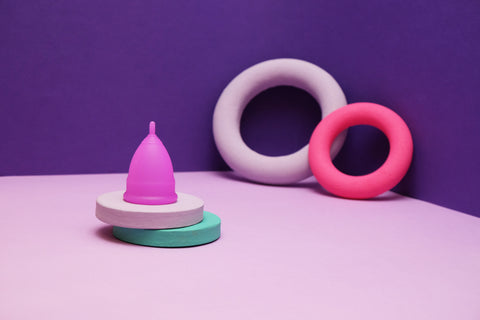Eco-friendly, reusable period care products have been on the rise for quite some time – amongst them, the menstrual cup. Many of you non-cup users are probably thinking ‘A cup? In there?’ Yes! Trust us, this little handy gadget will transform your periods and once you’re hooked you won’t look back!
So, what actually is a menstrual cup?
As the name suggests, a menstrual cup is a small, flexible cup most often made from medical grade silicone. A few cups are made from latex rubber or plastic, so be sure to double check what it’s made of if you have any allergies! The cup is inserted into your vagina just like you would insert a tampon without applicator and will then sit below your cervix and collect your period blood. Nowadays menstrual cups come in all forms, shapes, sizes, and even colours so there is one for (almost) everybody!

What is it that makes menstrual cups so much better than tampons or pads?
There really are a lot of benefits to using a menstrual cup! First of all, it’s amazing for the environment. While you are reading this there are about 74 million single-use period products littering the world’s coastlines. Shocking, right? Since menstrual cups are reusable, they help massively to reduce the amount of waste ending up in the ocean.
They are also a lot better for you, though! Did you know that a tampon can absorb up to 35% of the natural vaginal moisture in the course of a single period? That means that, especially on your lighter days, tampons can hurt the inner lining and irritate the area even more. Menstrual cups, on the other hand, only collect what actually needs to leave your body and don’t dry the vaginal canal out as much. In addition to that, they also don’t contain any chemical substances like the bleach often present in tampons and pads to lighten the cotton.
It doesn’t end there! If you look after your menstrual cup well it can last you up to 10 years. Can you already see how much money you would save if you didn’t have to buy tampons and pads every month? Menstrual cups can also hold more blood than most other period products which means that you don’t have to worry about emptying it every 4 hours like you would do with a tampon.

Where does the menstrual cup come from?
Menstrual cups sound like a modern concept, right? Well, they aren’t really! The first rubber cup was actually developed by Leona Chalmers in 1937. The idea, very much ahead of its time, was shelved pretty quickly after a lot of resistance and skepticism from the public and wasn’t picked up again until the 2000s.
How do you use a menstrual cup?
It all sounds very complicated and a bit scary at first but once you’ve got the hang of it it’s actually super easy, promise!
Before you start make sure your hands and your cup are squeaky clean – we don’t want to get anything up there that shouldn’t be up there, after all. If you have trouble inserting your cup try making your hands and cup wet and, if that still doesn’t work, you can even try a water-based lubricant (our very own OVIO personal works wonders). To insert it, the cup needs to be folded. Here are the most common folding techniques:
- C-fold: Flatten the cup and then fold it in half so it forms a C-shape.
- Shell fold: Push down one side of the cup into itself, creating a small tip to insert.
- 7-fold: Flatten the cup and fold the top right corner down to make 7 shape.
Once the cup is folded, either squat down or raise a leg to insert it. Now, most importantly, relax and take it slow! This is not a race and, as with everything new, it will take some time to find the technique that works best for you. The cup sits lower than a tampon would and should have approximately 1.5cm clear at the base (this is not exact science, just a guideline!). You shouldn’t be able to feel your menstrual cup once it’s in, so if it isn’t comfy it doesn’t sit properly. It’ll probably take a few tries if you’re new to the whole thing, but it gets easier the more often you do it!
When the cup is in the right position, you can release the fold and it will pop open. To create a proper seal, you can grab the base and rotate it slightly. If you’re still not sure that it’s sealed properly, you can very lightly pull at the stem – if you can feel resistance, you’re good to go!

The cup can then be worn for up to 8 hours without having to worry about it. When it’s time to take it out, follow the stem (you can pull very lightly) until you can reach the base of the cup. You can additionally help yourself by pushing the cup down with your pelvic floor muscles. Once you can reach the base, pinch it to break the seal and slowly wiggle it out. Empty the contents into the sink or toilet and give it a quick wash and wipe-down and you’re ready to reinsert it. There is no need to sterilise it in boiling water during your period and YES, you can totally wear the cup over night!
Once your period is over, the cup needs to be sterilised in boiling water. You can either do that straight after your period finishes or just before your next period – whatever works best for you! To sterilise your menstrual cup, simply get a pan, pop some boiling water in there and boil your cup for 5 minutes. Then store it in the little cotton pouch and keep safe until your next use.



Leave a Reply